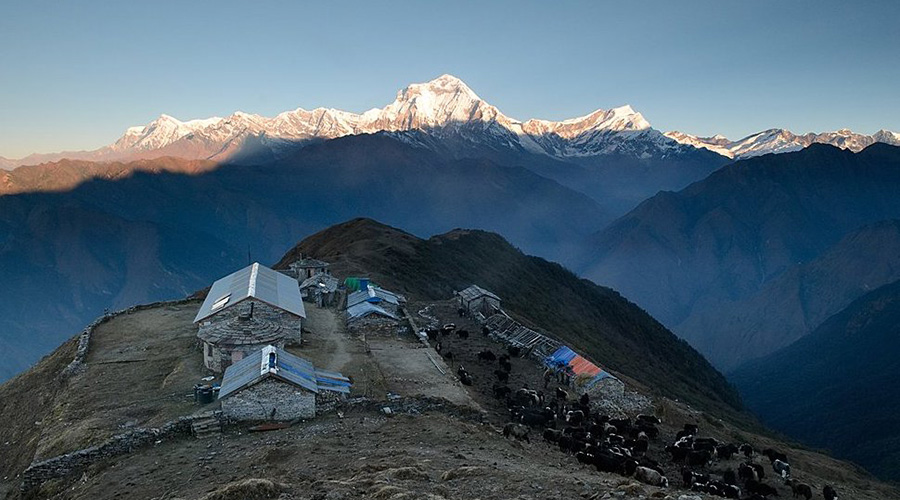

Email Us
contact@destinationhimalayatreks.com
Viber/Whats App 
+977-98510 16814 (Min Gurung)+977-98511 46814 (Tara Rana)
Khopra Hill Trek
Trip Facts
Overview
Khopra Hill or Danda is a newly discovered trekking route in the Annapurna region that is slowly gaining popularity. It lies in the northeast part of Pokhara neighboring Kaski and Myagdi districts. The trek route is off-beat and hence it is less crowded and more peaceful. A newly discovered spot in the Annapurna region to explore for those who want peace and uniqueness.
The trek route takes through the dense forest of rhododendron, oak, etc. with amazing magnificent views of Machhapuchhre, Annapurna, Dhaulagiri, Tukuche, and Nilgiri in the background. A day hike to holy Khayer Lake is magical and the close view of Annapurna South is outstanding. The trek route is well-blended with rich culture, natural beauty, natural wilderness, and an off-beat path that is perfect for trekking and exploring.
- Less crowded and more peaceful
- Dense forest of rhododendron and oak
- Green meadowlands
- Day hike to holy Khayer Lake (4600m)
- Splendid close-up views of Annapurna South from Khayer Lake
- Amazing magnificent views of Machhapuchhre, Annapurna,
- Dhaulagiri, Tukuche, and Nilgiri
- Perfect blend of rich culture, natural beauty, natural wilderness, and an off-beat path
Short Itinerary
Day 01: Kathmandu to Pokhara (tourist bus) 7 hours’ drive.
Day 02: Drive to Nayapul (1070m) and trek to Tikhedhunga (1500m) 4 hours trek
Day 03: Tikhedhunga to Ghorepani (2800m) 7 hours trek.
Day 04: Ghorepani to Swanta (2400m) 4 hours trek.
Day 05: Swanta to Dhankharka (Chistibung) (3000m) 4/5 hours trek.
Day 06: Dhankharka to Khopra Hill/Danda (3660m) 4 hours trek
Day 07: Khopra Hill/Danda to Khayer Lake (4600m) and back to Khopra
Day 08: Khopra Hill/Danda to Dobato (3425m) 7 hours trek
Day 09: Dobato to Ghandruk (2000m) 6 hours trek.
Day 10: Trek to Nayapul and drive to Pokhara.
Includes
- All required land transportation as required for trip
- Hotel in Kathmandu and Pokhara with breakfast
- Sightseeing tour in Kathmandu with guide and private vehicle
- TIMS (Trekking permit) and conservation park permit
- Foods and accommodation in trekking
- Well equipped trekking guide
- All allowances for guide
- Emergency evacuation service if in case needed
Excludes
- Foods in Kathmandu and Pokhara
- Your personal trekking gears and expenses
- Entry permits during sightseeing tour
- Emergency rescue cost if in case...
Detail Itinerary
-
Day 01: Kathmandu to Pokhara (tourist bus) 7 hours’ drive.
In the morning, after breakfast with your guide take a scenic ride to Pokhara on a tourist bus. After arriving at Pokhara, transfer to a hotel and take a rest. In the evening, wander the nearby streets or lakeside. Overnight in Pokhara.
-
Day 02: Drive to Nayapul (1070m) and trek to Tikhedhunga (1500m) 4 hours trek
After breakfast, drive to Nayapul. From Nayapul, commence your trek to Tikhedhunga. Witnessing the amazing scenery and natural greenery throughout the trail reach Tikhedhunga. Overnight in Tikhedhunga.
-
Day 03: Tikhedhunga to Ghorepani (2800m) 7 hours trek.
An interesting trek to the beautiful Ghorepani village starts after breakfast. Ascend to the lovely Magar village Ulleri and get the first sight of Mt. Annapurna and Machhapuchhre. On the trail, the surrounding natural beauty lures everyone. Continue to trek further and arrive at Ghorepani. Show your ACAP and TIMS permits to enter this region. Overnight in Ghorepani.
-
Day 04: Ghorepani to Swanta (2400m) 4 hours trek.
From Ghorepani, an easy trek descending the forested trail surrounded by oak, pine, and rhododendron. Also, traverse through a small river and keep descending until Swanta. Overnight in Swanta.
-
Day 05: Swanta to Dhankharka (Chistibung) (3000m) 4 to 5 hours trek.
After breakfast, trek to Dhankharka. Walk on the off-beat trail through the dense forest, ascend slowly, and pass through the meadowlands. Adoring the stunning mountains, and landscapes, and enjoying the walk to reach Dhankharka for an overnight stay.
-
Day 06: Dhankharka to Khopra Hill/Danda (3660m) 4 hours trek
Walk along the steep uphill path after breakfast. Pass through the dense forest, bushes, and pastures. Arrive at Khopra Danda and witness a breathtaking panoramic view of the snowy mountain ranges. Specially Annapurna and Dhaulagiri ranges are clearly seen and are outstanding. Overnight in Khopra Danda.
-
Day 07: Khopra Hill/Danda to Khayer Lake (4600m) and back to Khopra
A day hike to the sacred Khayer Lake for an excursion. One of the longest day hikes but rewarding. Several Hindus visit this holy lake during the Janai Purnima festival in the month of July/August. The path to reach Khayer Lake is steep and tough. Get outstanding views of Annapurna South (7,219m) from here along with beautiful neighboring mountains. Take some snaps and retrace the same trail back to Khopra for an overnight stay.
-
Day 08: Khopra Hill/Danda to Dobato (3425m) 7 hours trek
Walk through the blossoming rhododendron forest, passing green valleys, and admire the wonderful picturesque views descending to Dobato. Overnight in Dobato.
-
Day 09: Dobato to Ghandruk (2000m) 6 hours trek.
An easy descent walks to the pretty Ghandruk village in the vicinity of snow-clad mountains and beautiful breathtaking sceneries. Pass through the forest of rhododendron, and arrive at Ghandruk for an overnight stay. Get pleased with the warm hospitality of Gurung ethnics and learn a little about their culture and lifestyle.
-
Day 10: Trek to Nayapul and drive to Pokhara.
After breakfast, trek to Nayapul for a few hours. Then, take a drive to Pokhara in a public vehicle. Spend the day exploring the lakeside, and enjoy the nightlife. Overnight in Pokhara.
-
Khopra Hill Trek Information
Accommodation
Accommodations in the Khopra Hill Treks are mostly community lodges. The community lodges are comfortable with basic facilities and run by families. So, feel at home and get warm hospitality from the families. The extra charge must be paid for the use of facilities like hot water buckets, laundry, charging, internet, and electricity.
Meals
Breakfast, Lunch, and Dinner are provided during the trekking from the community lodges. The meals are basic and suitable for the health of the trekkers. The main dish is Nepali Dal Bhat which provides enough energy throughout 7/8 hours of the trek. The variety of meals is hard to find but meals prepared from home-grown crops are a treat during this trek.
Drinking waterDrinking water is easily available at the lodges. You can buy a mineral water bottle but you should do proper disposal of plastic bottles. You can also fill boiled water at lodges paying extra charges. Always carry a water bottle and water purification medicine to prevent unwanted health issues. During trekking, drink direct freshwater from the flowing stream using water purification treatment.
Communication
The internet facility is easily available in the vicinity of the Annapurna region. The internet is fairly stable in the lower regions. By paying extra charges at lodges, internet facility, electricity for charging can be used. The phone signal is also good in the lower regions. Using a local sim card, an internet facility can also be used.
Starting and Ending pointsThe starting point of the Khopra Hill/Danda Trek is from Nayapul and ends in Nayapul. Take a drive to Pokhara from Nayapul.
Nayapul-Tikhedhunga-Ghorepani-Swanta-Dhankharka-Khopra Hill/Danda-Khayer Lake-Khopra Hill-Dobato-Ghandruk-Nayapul-PokharaRequired Permits
Annapurna Conservation Area Project (ACAP) and Trekkers Information Management System (TIMS) permits are required.
ACAP permit cost charge: NPR 3000 (Foreigners), NPR 1000 (SAARC)
TIMS permit cost charge: NPR 2000 (Foreigners), NPR 600 (SAARC)Travel Insurance
Travel Insurance is very helpful and a safety net for travelers/trekkers. Travel Insurance must cover all medical emergencies, flight cancelations, emergency evacuations, loss of luggage, and altitudes over 3000 m.
Safety and our guides
We assure you 100% when it comes to safety. Our client’s safety is our main concern. Our guides are certified and well-trained with years of expertise in this field. They are technically competent and have excelled in safety performance. They always carry essential safety equipment, gear, and first-aid kits. For the safety of our trekkers, the itinerary is properly scheduled. If any queries concerning safety, feel free to share them with our guides. We are always there for your services.
Best time for Khopra Hill Trek
Khopra Hill Trek can be done all year round. But still, Spring and Autumn seasons are the best time followed by the summer season. The weather is clear and sunny during these seasons. The trail is also comfortable to walk. Rainy and Winter season treks are for experienced trekkers. The trails are muddy, slippery, and snowy during these seasons making it tough for trekkers to trek. The weather is very cold during the winter and continuous rains during the rainy season. The view is also not clear during these seasons. Only a few adventurous trekkers dare to trek during these seasons. We recommend you plan carefully if you want to trek during the off-season.
Khopra Hill Trek Difficulty
Khopra Hill Trek’s difficulty is easy to moderately challenging. The trek includes a trail having some steep ascends, descends, and some rough trails. The trekker with average physical fitness and good health condition can complete the trek. Proper preparation and guidance before starting the trek are fruitful. So, we recommend you participate in exercises, day hikes, and physical training months before starting the trek. Also, take necessary health tests before trekking to high altitudes. You can completely trust our assistance and guidelines throughout the trekking journey.
Acclimatization and Altitude Sickness
Acclimatization rest is necessary during trekking. The trek starts from Nayapul (1,070m) and the altitude rises to Khayer Lake (4,600m) during the trek. So, in between the treks, upon reaching your daily destinations acclimatize properly. Walk to the surroundings to adapt to the environment and prevent altitude sickness.
Symptoms of Altitude Sickness
Primary: Headache, nausea, gasping, appetite & sleep loss, dizziness, fatigue, vomiting
Extreme: primary symptoms and hallucinations & unconsciousnessPreventive Guidelines
- Immediately inform the guide
- Warm-up, and body stretch before the trekking journey
- Drink water and Hydrate yourself at regular intervals
- Frequent urination throughout the journey
- Ascend slowly and gradually
- Take plenty of rest and sleep
- Avoid salty foods, alcohol, and smoking
- Descend immediately when it’s difficult/uneasy
- Take medicine consulting a guide
Shoes: Pair of hiking boots, Rubber sandals
Clothes: Windcheater jacket, Thermals, Down Jacket, Fleece, Long sleeve shirts, Gloves, Towels, Inner garments, Trekking pants, Trousers, Shorts, Socks
Accessories: Sunglasses, Ski Goggles, Hats/Caps, Beanie, Sunscreen, Lip Balm, Head Lamp, Pocket Knife, Personal Hygiene &Toiletries
Equipment: Warm Sleeping bags, Map, Trekking poles, Duffel bag
Medicine Kit: Wash Kit, First-Aid Kit, Blister Repair Kit, Medicines for preventing Altitude sickness, Prescribed Medicines (Personal use)
Rainy season: Waterproof clothes, boots, Raincoat, Anti-leech socks
Winter Season: Woolen clothing items (light)
Extras: Heat/Leak proof water bottles, Water Purifying solution (Iodine based), Water filters, Insulated cup/flask, Map, Binoculars, Travel Documents, Sewing kit, Cash, Extra batteries, Power bank, Pen, Diary, Book, Reusable (spoon, cup, plate), Reusable bags, Large Waterproof Disposable Bags, Snacks (Choco-bars, Mints, Nuts, Granola Bars)
It is best to bring the clothes and essential equipment from your home from the provided checklist. Also, you can buy or rent equipment and clothes in Kathmandu. You can customize the checklist as a necessity.
